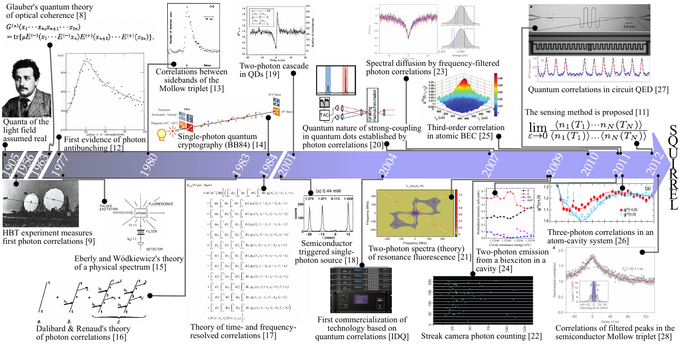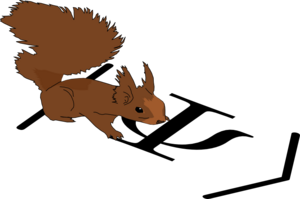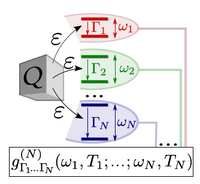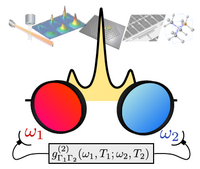m (→SQUIRREL) |
m (Squirrel is on!) |
||
| Line 1: | Line 1: | ||
| − | = SQUIRREL = | + | [[File:squirrel-2014.png|300px|right]] |
| + | |||
| + | = SQUIRREL = | ||
| + | |||
| + | This is [[Elena]]'s Marie Curie project ([http://ec.europa.eu/research/mariecurieactions/about-mca/actions/ief/index_en.htm IEF-Fellowships for career development], FP7-PEOPLE-2012-IEF) at the Universidad Autónoma de Madrid, starting March 2014. [[Fabrice]] is the scientist in charge. | ||
| + | |||
| + | == Goals == | ||
| + | |||
| + | Quantum correlations are those supporting technologies such as quantum information processing. For realistic applications, one has to consider open quantum systems, that is, in contact with the classical world through lifetime and excitation. | ||
| + | |||
| + | [[File:sensing-scheme.png|200px|left]] | ||
| + | |||
| + | Quantum correlations are transferred through emitted photons, electrons, etc. and characterise the quantum structure of the system and its suitability as a quantum device. The state-of-the-art is the [http://en.wikipedia.org/wiki/Hanbury_Brown_and_Twiss_effect Hanbury Brown-Twiss two-photon coincidence counting], which is a particular case of the general problem. At the speed of technological progress, it is now becoming possible to measure higher order correlations of quanta characterised in all their attributes. For instance, cross-correlating photons with fixed frequencies and arrival times is now a routine practice in many laboratories worldwide. The correct interpretation and mastering of such techniques will allow a robust implementation of quantum protocols. | ||
| + | |||
| + | [[File:sensing-example-Mollow.png|200px|right]] | ||
| + | |||
| + | Theoretically, the computation of such correlations is complicated and tedious as it needs to keep in the calculation all the degrees of freedom for each carrier. Our recently developed general formalism, "[http://journals.aps.org/prl/abstract/10.1103/PhysRevLett.109.183601 the sensing method]", allows to deal for the first time with [http://iopscience.iop.org/1367-2630/15/3/033036/ complicated quantum systems], with many degrees of freedom and particles, and to compute Nth-order correlations, with N>2, at arbitrary times and frequencies. | ||
| + | |||
| + | (See the [http://bcove.me/1zaofsvh video abstract] for a quick introduction to the topic) | ||
| + | |||
| + | The goal of the SQUIRELL project is to develop and disseminate this novel and interdisciplinary theoretical approach in a wide range of quantum systems (cavity QED, superconducting circuits, atomic and [http://iopscience.iop.org/1367-2630/15/2/025019 semiconductor systems], plasmonic, Bose-Einstein condensates, etc.), by analysing the physics made accessible by the sensing method, by supporting experiments on quantum correlations in a variety of fields and by exploiting correlations to improve and design new quantum devices. | ||
| + | |||
| + | == Context == | ||
<center> | <center> | ||
<span style="font-variant: small-caps;">'''S'''ensing '''QU'''antum '''I'''nformation co'''RREL'''ations</span> | <span style="font-variant: small-caps;">'''S'''ensing '''QU'''antum '''I'''nformation co'''RREL'''ations</span> | ||
| − | |||
<wz tagtotip=squirrel>[[File:squirrel.png|680px]]</wz></center> | <wz tagtotip=squirrel>[[File:squirrel.png|680px]]</wz></center> | ||
<span id="squirrel">Timeline of breakthroughs providing a background to the SQUIRREL Project.</span> | <span id="squirrel">Timeline of breakthroughs providing a background to the SQUIRREL Project.</span> | ||
Revision as of 13:33, 2 March 2014
SQUIRREL
This is Elena's Marie Curie project (IEF-Fellowships for career development, FP7-PEOPLE-2012-IEF) at the Universidad Autónoma de Madrid, starting March 2014. Fabrice is the scientist in charge.
Goals
Quantum correlations are those supporting technologies such as quantum information processing. For realistic applications, one has to consider open quantum systems, that is, in contact with the classical world through lifetime and excitation.
Quantum correlations are transferred through emitted photons, electrons, etc. and characterise the quantum structure of the system and its suitability as a quantum device. The state-of-the-art is the Hanbury Brown-Twiss two-photon coincidence counting, which is a particular case of the general problem. At the speed of technological progress, it is now becoming possible to measure higher order correlations of quanta characterised in all their attributes. For instance, cross-correlating photons with fixed frequencies and arrival times is now a routine practice in many laboratories worldwide. The correct interpretation and mastering of such techniques will allow a robust implementation of quantum protocols.
Theoretically, the computation of such correlations is complicated and tedious as it needs to keep in the calculation all the degrees of freedom for each carrier. Our recently developed general formalism, "the sensing method", allows to deal for the first time with complicated quantum systems, with many degrees of freedom and particles, and to compute Nth-order correlations, with N>2, at arbitrary times and frequencies.
(See the video abstract for a quick introduction to the topic)
The goal of the SQUIRELL project is to develop and disseminate this novel and interdisciplinary theoretical approach in a wide range of quantum systems (cavity QED, superconducting circuits, atomic and semiconductor systems, plasmonic, Bose-Einstein condensates, etc.), by analysing the physics made accessible by the sensing method, by supporting experiments on quantum correlations in a variety of fields and by exploiting correlations to improve and design new quantum devices.
Context
Sensing QUantum Information coRRELations

Timeline of breakthroughs providing a background to the SQUIRREL Project.


